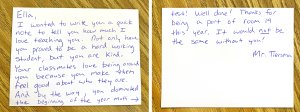The Value of Mailing Encouraging Notes to Students
Looking for positive things to say about every student helps teachers develop an asset-based approach to teaching—and helps students lean into their strengths.
Your content has been saved!
Go to My Saved Content.Early in my teaching career, I found out that a friend and mentor would periodically write encouraging notes to give to his struggling high school social studies students. I was intrigued and decided to write one of my middle school students a personalized note and drop it in the mail.
Everything I wrote was about him: his character, why I liked teaching him, even a challenge to him for the year. That one note has turned into many. My goal was always to write one note for every student I taught, and more years than not, I accomplished that goal. As a middle school teacher, I set aside time to write about five cards a week, and by the end of the year, I had sent home more than 100 personalized, handwritten notes to my seventh-grade students. Now that I’m an elementary school teacher, I have fewer to write, and I try to send each child a note in the first eight weeks of the year.
The response to these messages has been extraordinary and quite humbling. Every year, a few students write back with their own priceless words. Many display the notes on the front of their binder, while others pin them up in their bedrooms. One former student, according to her mom, took the 7-year-old note with her to college to display it on her dorm room wall above her desk.
Feeling Important Is Important
These notes have exposed an important truth: Students have a deep desire to be known. Students recognize that time was set aside for them, that they’re worth being known. The handwritten card is something they can hold that shows that someone knows them and loves them.
Believing they are valuable has helped my students become much more engaged in the classroom. They want to do well, knowing their teacher is on their team. Plus, now that the positive things about them have been named, they are empowered to lean into the behaviors and characteristics that they recognize in themselves.

I’ve noticed some adjustments to my thinking, too. The process has changed how I view my students. Starting on day one, I’m motivated to have a positive view of them. I look for “the good” in them, knowing that I will be sending a note home soon. Even as I’m searching for material, I make sure that my words are specific, genuine, and true.
Sometimes I wonder if the parents enjoy the notes more than the students. Parents have called me, crying tears of appreciation. But it makes sense. It must be extremely satisfying for someone else to recognize what you already believe about your child—they are special. The note also gives the parent a glimpse into how I’m choosing to view their child and that to me their child isn’t just another student.
Another Way to Connect
The success of the handwritten notes inspired me to look for other ways to connect with my students, such as authentic conversations. Every day, I look for opportunities to have conversations with students about non-school topics. The goal of having at least one meaningful conversation a day, each with a different student, has been another powerful way to build relationships and increase student engagement.
Finding time for one-on-one conversations might seem unrealistic, especially for middle and high school teachers, but it is possible. Using class time is ideal because your students are available, sitting right in front of you. Try reserving the first or last two minutes of your class time for interacting with an individual student. This type of commitment will show your students how much you value them as individuals.
If you don’t have time in your class period, don’t let that stop you. Get creative. Drink your morning coffee in the hallway and greet students as they arrive at school. Ask them how they did in their swim meet or if they’re nervous about their part in the musical. Find a student to talk to as you walk to the teachers’ lounge at break or lunch. Use their name, ask good questions, and be intentional with every conversation.
Getting Started
Want to start with the handwritten note idea? Start small. Look at your class roster, pick someone who needs encouragement, and write the note. Drop it in the mail and wait a few days. You’ll know they’ve received it by the look on their face.
Rather begin with one-on-one intentional conversations? Pick someone you don’t know that well. Find out what they love, what they like to do, and what you have in common. Make it all about them.
When teachers go out of their way because they care, students know it. They can see it, and they can feel it. Handwritten notes and intentional conversations are just a few of the tools that teachers can use to show students that they see them, they hear them, they know them, and they care about them. Try one of these ideas today. Your relationship with your students will be all the better for it.
